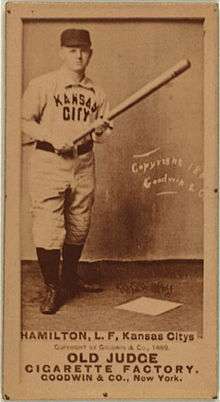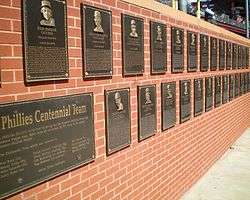Billy Hamilton (baseball, born 1866)
| Billy Hamilton | |||
|---|---|---|---|
 | |||
| Outfielder | |||
|
Born: February 16, 1866 Newark, New Jersey | |||
|
Died: December 16, 1940 (aged 74) Worcester, Massachusetts | |||
| |||
| MLB debut | |||
| July 31, 1888, for the Kansas City Cowboys | |||
| Last MLB appearance | |||
| September 16, 1901, for the Boston Beaneaters | |||
| MLB statistics | |||
| Batting average | .344 | ||
| Stolen bases | 912 or 914 or 937Steals discrepancy | ||
| Runs scored | 1690 | ||
| Teams | |||
| |||
| Career highlights and awards | |||
| |||
| Member of the National | |||
| Inducted | 1961 | ||
| Election Method | Veteran's Committee | ||
William Robert "Sliding Billy" Hamilton (February 16, 1866 – December 16, 1940) was a 19th-century Major League Baseball (MLB) player who holds a number of baseball records. He played for the Kansas City Cowboys, Philadelphia Phillies and Boston Beaneaters between 1888 and 1901. He was elected to the National Baseball Hall of Fame and Museum in 1961. As of 2016, he is third on the all-time list of career stolen bases leaders.
Early life
Hamilton was born on February 16, 1866[1] in Newark, New Jersey. His parents, Samuel and Mary Hamilton, had immigrated to New Jersey from Ireland. Biographer Roy Kerr writes that evidence suggests that Hamilton was descended from the Ulster Scots people. (As an adult, Hamilton was known to proudly proclaim his Scottish ancestry.) When Hamilton was a small child, his family moved to Clinton, Massachusetts.[2] He worked in a Clinton cotton mill as a young teenager.[3]
Professional career
Hamilton broke into the major leagues in the American Association with the Kansas City Cowboys in 1888. He established himself as a star the following season by batting .301 with 144 runs and 111 stolen bases. In 1890, the Cowboys, who were ceasing operations, sold Hamilton to the Philadelphia Phillies. The next year he led the NL in batting average (.340), runs scored (141) and hits (179). For a third consecutive season, Hamilton led the NL in stolen bases.
In 1892, Hamilton hit both a leadoff and game-ending home run in the same game. Only Vic Power (1957), Darin Erstad (2000), Reed Johnson (2003) and Ian Kinsler (2009) have accomplished the same feat.[4] He hit .380 in 1893, which led the major leagues.
Philadelphia outfielders Hamilton, Sam Thompson, Ed Delahanty and Tuck Turner all hit over .400 in 1894. That year Hamilton set the all-time standard for most runs scored in a season (198); since then, Babe Ruth has come closest to Hamilton in runs scored, with 177 in 1921, setting the American League and modern MLB record. Hamilton also set the record for most stolen bases in one game, with seven on August 31, 1894. He set the record for most consecutive games scoring one or more runs, with 35 runs in 24 games in July–August 1894.[5]
Hamilton led the league in steals for a fifth time in 1895. In 1896, Hamilton moved to Boston, for whom he played his final six seasons. Although his numbers declined, Hamilton still scored over 100 runs in all but two of those seasons.
Hamilton retired after the 1901 season. Over his career he compiled 912 (or 937; see Career total discrepancy) stolen bases, a .344 batting average and 1690 runs in 1591 games; he is one of only three players to average more than one run per game played. His .455 career on-base percentage ranks fourth all-time behind Ted Williams, Babe Ruth and John McGraw, and his 912 stolen bases ranks third behind Rickey Henderson and Lou Brock.
He is the Philadelphia Phillies career leader in batting average (.361), on-base percentage (.468) and stolen bases (508). He holds Phillies single-season records for on-base percentage (.523 in 1894), runs (196 in 1894), stolen bases (111 in 1891) and times on base (355 in 1894).
Legacy
Though stolen bases were credited differently during Hamilton's career than they are in modern times, he was very proud of his stolen base marks. In 1937, Hamilton lambasted the Sporting News in a letter he wrote to them, stating, "I was and will be the greatest base stealer of all time. I stole over 100 bases on many years and if they ever re-count the record I will get my just reward." [6]
His career steals total differs, based on the source. Hamilton's plaque in the Baseball Hall of Fame credits him with 937 steals,[7] while MLB.com credits him with 912 steals[8] and Baseball Reference.com credits him with 914 steals.[9]
Later life
After his playing days ended, Hamilton managed several minor league teams in Pennsylvania and Massachusetts and served as a scout with the Boston Nationals.[10]
Hamilton was inducted into the Baseball Hall of Fame in 1961. He was the first New Jersey native so honored, and remains the on;y one from the northern part of the state, with Joe Medwick from Carteret in central New Jersey; and Goose Goslin was from Salem in South Jersey, Alabama-born Monte Irvin grew up in East Orange and South Carolina-born Larry Doby, and Troy, NY born Mike 'King' Kelly both grew up in Paterson.
Hamilton died on December 15, 1940 at his home at 6 Lucian Street in Worcester, Massachusetts. He was survived by his wife Rebecca (Carr) Hamilton, four daughters and two grandchildren.[10]
See also
- List of Major League Baseball career hits leaders
- List of Major League Baseball career runs scored leaders
- List of Major League Baseball batting champions
- List of Major League Baseball stolen base records
- List of Major League Baseball career stolen bases leaders
- List of Major League Baseball annual runs scored leaders
- List of Major League Baseball annual stolen base leaders
- List of Philadelphia Phillies team records
Notes
- ↑ While most sources list this date of birth, biographer Roy Kerr writes that Newark archives suggest a date of birth of February 15, 1866.
- ↑ Kerr, pp. 38-39.
- ↑ Kerr, p. 40.
- ↑ Andro, Anthony, "Francisco goes back on DL because of pneumonia", Fort Worth Star-Telegram, 7/20/09, accessed 9/16/09
- ↑ Solomon, Abbot Neil (1988). Baseball Records Illustrated, Quintet Publishing, London.
- ↑ Russell Roberts (1999) Stolen!: A History of Base Stealing, McFarland, ISBN 0-7864-0650-X Excerpt, pg. 30
- ↑ Hamilton, Billy. Baseball Hall of Fame. Retrieved on April 12, 2014.
- ↑ MLB.com Hamilton stats
- ↑ Billy Hamilton Statistics and History. Baseball-Reference.com. Retrieved on April 12, 2014.
- 1 2 "Billy Hamilton, 74, ex-baseball star". New York Times. December 16, 1940. Archived from the original on December 17, 1940. Retrieved January 9, 2016.
References
- Kerr, Roy (2009). Sliding Billy Hamilton: The Life and Times of Baseball's First Great Leadoff Hitter. McFarland. ISBN 0786489197.
External links
- Billy Hamilton at the Baseball Hall of Fame
- Career statistics and player information from Baseball-Reference, or Fangraphs, or Baseball-Reference (Minors)
